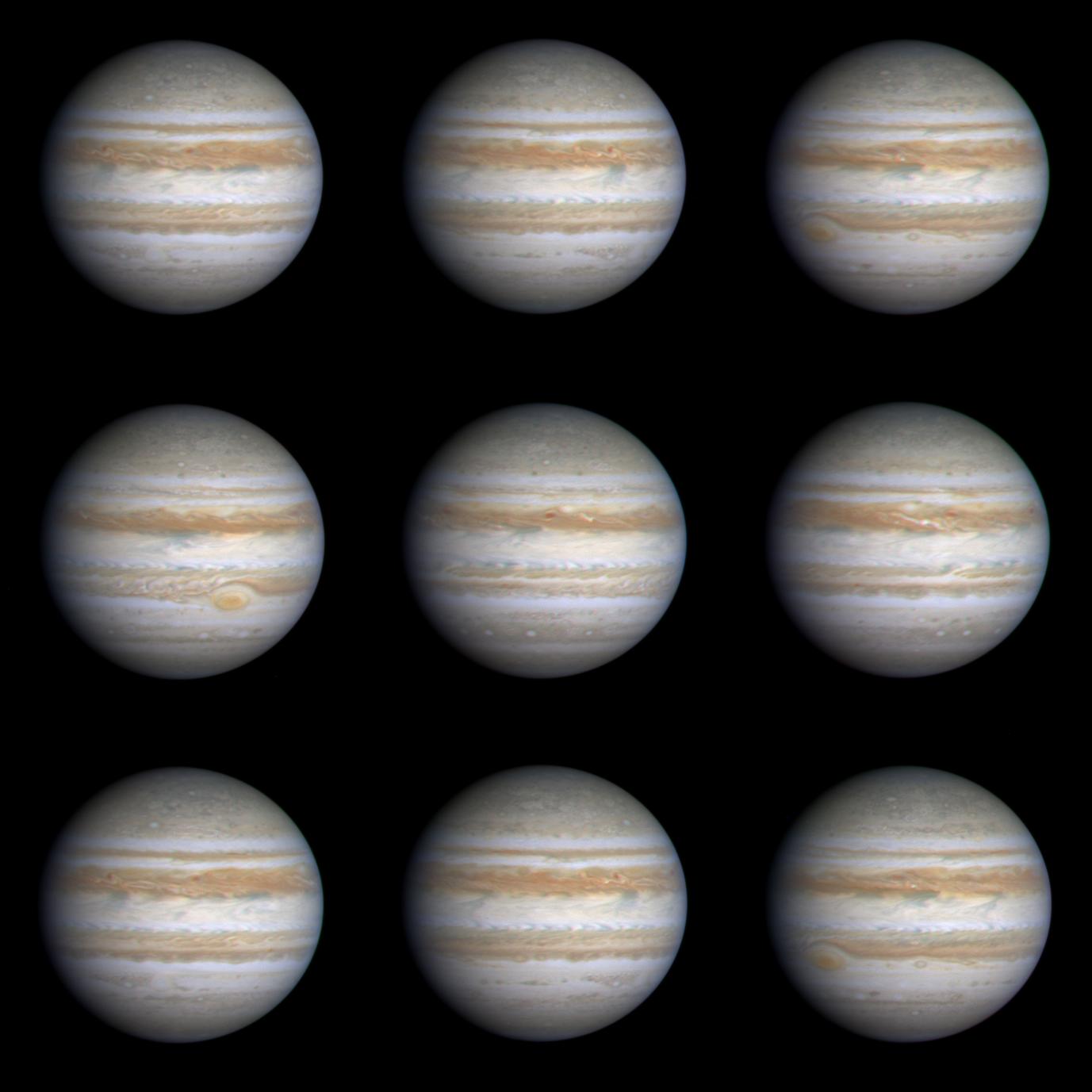Full Rotation

| PIA Number | PIA02825 |
|---|---|
| Language |
|
This sequence of nine true-color, narrow-angle images shows the varying
appearance of Jupiter as it rotated through more than a complete
360-degree turn. The smallest features seen in this sequence are no bigger
than about 380 kilometers (about 236 miles).
Rotating more than twice as fast as Earth, Jupiter completes one rotation
in about 10 hours. These images were taken on Oct. 22 and 23, 2000. From
image to image (proceeding left to right across each row and then down to
the next row), cloud features on Jupiter move from left to right before
disappearing over the edge onto the nightside of the planet. The most
obvious Jovian feature is the Great Red Spot, which can be seen moving
onto the dayside in the third frame (below and to the left of the center
of the planet). In the fourth frame, taken about 1 hour and 40 minutes
later, the Great Red Spot has been carried by the planet's rotation to the
east and does not appear again until the final frame, which was taken one
complete rotation after the third frame.
Unlike weather systems on Earth, which change markedly from day to day,
large cloud systems in Jupiter's colder, thicker atmosphere are
long-lived, so the two frames taken one rotation apart have a very similar
appearance. However, when this sequence of images is eventually animated,
strong winds blowing eastward at some latitudes and westward at other
latitudes will be readily apparent. The results of such differential
motions can be seen even in the
still frames shown here. For example, the clouds of the Great Red Spot
rotate counterclockwise. The strong westward winds northeast of the Great
Red Spot are deflected around the spot and form a wake of turbulent clouds
downstream (visible in the fourth image), just as a rock in a rapidly
flowing river deflects the fluid around it.
The equatorial zone on Jupiter is currently bright white, indicating the
presence of clouds much like cirrus clouds on Earth, but made of ammonia
instead of water ice. This is very different from Jupiter's appearance 20
years ago, when the equatorial zone was more of a brownish cast similar to
the region just to its north.
At the northern edge of the equatorial zone, local regions colored a dark
grayish-blue are places where the ammonia clouds have cleared allowing a
view to deeper levels in Jupiter's atmosphere. Interrupting these
relatively clear regions is a series of bright arrow-shaped equatorial
plumes. The most obvious one is visible just above and to the right of
center in the third and ninth frames. These plumes resemble the `anvil'
clouds that accompany common summer thunderstorms on Earth, although the
Jovian plumes are much bigger, and their somewhat regular spacing around
the planet suggests an association with a planetary-scale wave motion. The
southwest-northeast tilt of these plumes suggests that the winds in this
region act to help maintain the eastward winds at this latitude.
In the dark belt north of the equatorial zone, a turbulent region with a
white filamentary cloud is visible in the sixth frame, indicating rapidly
changing wind direction. Several white ovals are visible at higher
southern latitudes (toward the bottom of the fourth, fifth, and sixth
frames, for example). These ovals, like the Great Red Spot, rotate
counterclockwise and are similar in some respects to high-pressure systems
on Earth.
When these images were taken, Cassini was about 3.3 degrees above
Jupiter's equatorial plane, and the Sun-Jupiter-spacecraft angle was about
20 degrees.
JPL manages the Cassini mission for NASA's Office of Space Science,
Washington, D.C. JPl is a division of the California Institute of
Technology in Pasadena.
Credit: NASA/JPL/University of Arizona. (PIA02825A)
For higher resolution, click here.
